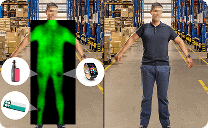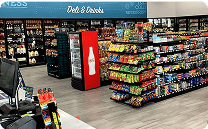Intrusion detection refers to the technologies and strategies used to monitor physical environments to prevent unauthorized access or suspicious activity. It plays a central role in business security, helping organizations detect threats early, minimize response times, and significantly reduce the risk of loss, damage, or injury, instilling a sense of confidence and control.
In practice, intrusion detection systems (IDS) consist of hardware and software components that continuously monitor entry points, such as doors, windows, and perimeter boundaries, for signs of tampering or unauthorized movement. When a threat is identified, the system creates alerts that can be sent to on-site personnel, a monitoring center, or mobile devices for immediate action.
While intrusion detection is commonly associated with after-hours protection, it also plays a crucial and versatile role during business hours by monitoring sensitive areas such as cash rooms, restricted storage, back-of-house corridors, and employee-only zones, making your security measures adaptable and prepared for various scenarios.
How Intrusion Detection Systems Work
An intrusion detection system typically includes:
- Sensors: Devices such as motion detectors, door/window contacts, glass break sensors, vibration detectors, and infrared beams are installed at critical points throughout a facility.
- Control Units: These process data from the sensors and determine whether to trigger an alert based on predefined conditions.
- Alert Mechanisms: Alarms, push notifications, text messages, or direct feeds to central monitoring centers help ensure a rapid response when a breach is detected.
- System Interfaces: Touchscreens, keypads, or mobile apps allow users to arm or disarm systems, review logs, and adjust system behavior.
Advanced systems may also include intelligent zoning, allowing custom monitoring rules based on time of day, employee schedules, or access permissions.
Types of Intrusion Detection
Intrusion detection solutions come in several forms depending on the size, layout, and risk profile of the environment:
- Perimeter Detection: Uses outdoor sensors or beam-based systems to detect breaches before a building is physically accessed.
- Interior Detection: Focuses on indoor areas, especially those with high-value inventory, sensitive data, or critical operations.
- Passive Infrared (PIR) Sensors: Detect changes in ambient heat signatures caused by a person moving through a monitored area.
- Glass Break and Contact Sensors: Trigger alerts when shattered glass or doors/windows are unexpectedly opened.
Some systems combine multiple sensor types for layered detection, enhancing reliability and helping reduce false positives.
Integration with Surveillance and Access Control
When intrusion detection is integrated with surveillance and access control systems, the result is a more intelligent and context-aware security solution. For example:
- A triggered door sensor can cue a nearby security camera to begin recording or bookmark footage for future investigation.
- An unauthorized access attempt can be cross-referenced with access badge logs to verify who was present at the time.
- Footage tied to an intrusion alert can be sent to managers or regional security leads for immediate visual verification.
These integrations help security teams prioritize responses and minimize disruption while supporting audits and investigations.
Benefits of Intrusion Detection
An effective intrusion detection system helps businesses:
- Deter unauthorized activity before it escalates into loss or damage.
- Protect employees and customers by maintaining a secure environment.
- Respond faster to incidents through real-time alerts and verification tools.
- Help ensure regulatory and insurance compliance with proper logging and documentation.
- Reduce operational downtime by preventing or limiting damage or loss from intrusions.
Intrusion detection is especially valuable for businesses operating across multiple sites, where centralized monitoring and consistent security standards are essential.
Intelligent Intrusion Detection Starts with DTiQ
DTiQ enhances intrusion detection by integrating alert systems with real-time intelligent video verification, analytics, and centralized management. Whether an after-hours entry, a perimeter breach, or unauthorized access to restricted zones, DTiQ helps your team respond quickly, reduce false alarms, and stay in control. With DTiQ, you’re not just alerted—you’re equipped to take action confidently. Learn more about our VIDEOiQ intelligent video solutions.





























